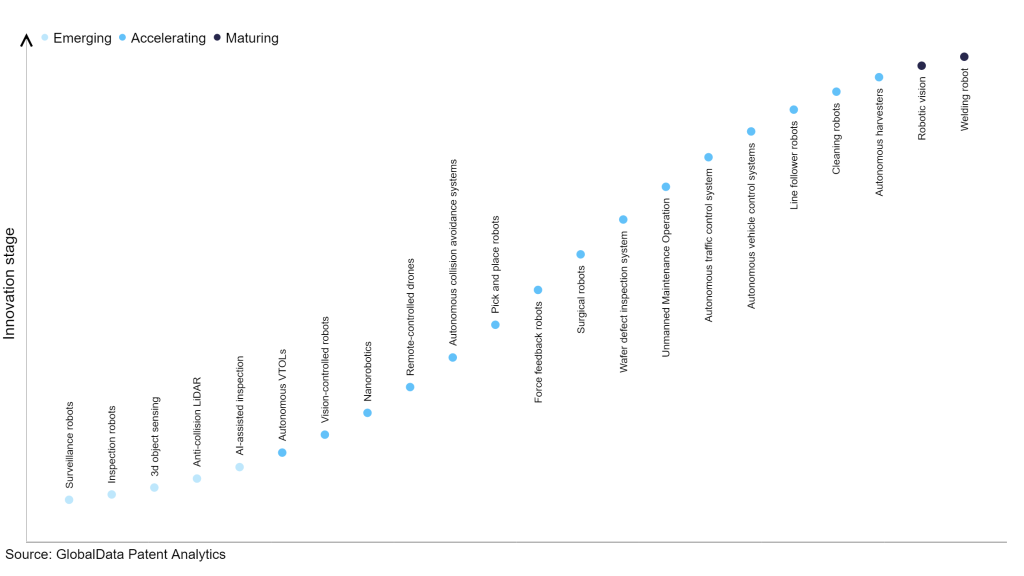The technology industry continues to be a hotbed of innovation, with activity driven by advanced robotics and sensors, machine learning, and artificial intelligence (AI), as well as growing importance of technologies such as laser diodes, photodetectors, signal processing algorithms, data fusion, and advanced light detection and ranging (LiDAR) systems to ensure the safety and reliability of autonomous systems in various industrial applications. In the last three years alone, there have been over 3.6 million patents filed and granted in the technology industry, according to GlobalData’s report on Innovation in Robotics: Anti-collision LiDAR. Buy the report here.
However, not all innovations are equal and nor do they follow a constant upward trend. Instead, their evolution takes the form of an S-shaped curve that reflects their typical lifecycle from early emergence to accelerating adoption, before finally stabilising and reaching maturity.
Identifying where a particular innovation is on this journey, especially those that are in the emerging and accelerating stages, is essential for understanding their current level of adoption and the likely future trajectory and impact they will have.
300+ innovations will shape the technology industry
According to GlobalData’s Technology Foresights, which plots the S-curve for the technology industry using innovation intensity models built on over 2.5 million patents, there are 300+ innovation areas that will shape the future of the industry.
Within the emerging innovation stage, AI-assisted inspection, anti-collision LiDAR, and 3d object sensing are disruptive technologies that are in the early stages of application and should be tracked closely. Autonomous harvesters, cleaning robots, and line follower robots are some of the accelerating innovation areas, where adoption has been steadily increasing. Among maturing innovation areas, welding robot and robotic vision are now well established in the industry.
Innovation S-curve for robotics in the technology industry

Anti-collision LiDAR is a key innovation area in robotics
Anti-collision LiDAR refers to a specific form of light detection and ranging (LiDAR) technology, which is utilised to detect objects in a designated space and prevent collisions. The mechanism operates by emitting laser beams into the surroundings, which subsequently bounce off objects in close proximity and are captured by a detector. This information is subsequently utilised to construct a three-dimensional representation of the environment, enabling the identification and avoidance of potential barriers.
GlobalData’s analysis also uncovers the companies at the forefront of each innovation area and assesses the potential reach and impact of their patenting activity across different applications and geographies. According to GlobalData, there are 40+ companies, spanning technology vendors, established technology companies, and up-and-coming start-ups engaged in the development and application of anti-collision LiDAR.
Key players in anti-collision LiDAR – a disruptive innovation in the technology industry
‘Application diversity’ measures the number of different applications identified for each relevant patent and broadly splits companies into either ‘niche’ or ‘diversified’ innovators.
‘Geographic reach’ refers to the number of different countries each relevant patent is registered in and reflects the breadth of geographic application intended, ranging from ‘global’ to ‘local’.
Patent volumes related to anti-collision LiDAR
Source: GlobalData Patent Analytics
Ford Motor is one of the leading patent filers in anti-collision LiDAR. The company’s patents are aimed at a system comprising a camera to capture an image of a forward path of the vehicle, a screen to display the image, and a processor, which can respond to an input to the screen by identifying and measuring the distance between two edges of at least one object of the image.
Other prominent patent filers in the anti-collision LiDAR space include Amazon and Alphabet.
In terms of geographic reach, ELMOS Semiconductor leads the pack, followed by BAE Systems and SoftBank Group. In terms of application diversity, State Farm Mutual Automobile Insurance holds the top position, followed by Aptiv and Magna International.
Anti-collision LiDAR technology enhances safety, enables collision avoidance, provides accurate object detection and classification, finds diverse applications, complements other sensors, and contributes to the advancement of autonomous technology. To further understand how robotics is disrupting the technology industry, access GlobalData’s latest thematic research report on Robotics – Thematic Research Report.
Data Insights
From

The gold standard of business intelligence.
Blending expert knowledge with cutting-edge technology, GlobalData’s unrivalled proprietary data will enable you to decode what’s happening in your market. You can make better informed decisions and gain a future-proof advantage over your competitors.







